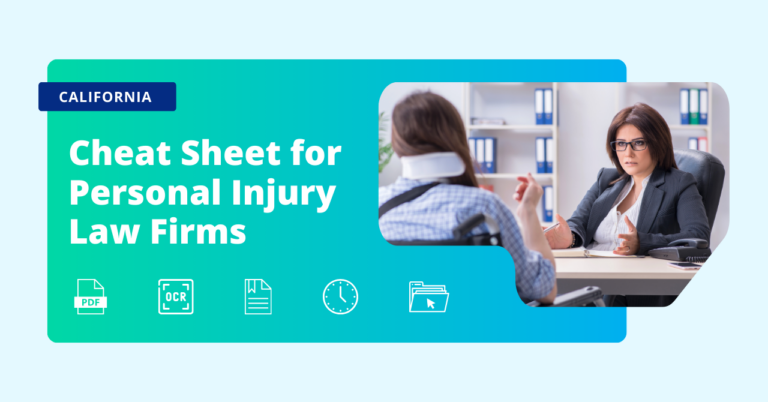Most days in personal injury law barrel along on a continuum of quick decisions, balancing client advocacy with the challenge of deep-pocketed insurance companies. It’s not for the faint of heart—and some days you may feel like you practice more medicine than law. But behind the chaos, one truth remains: a single document can make or break your case.
This article is here to make sure that eFiling court documents doesn’t become an obstacle in your litigation. With these expert tips, you’ll file correctly the first time, keeping your focus where it belongs, winning at trial or securing the best settlement.
Let’s begin with some foundational steps for success.

Essential eFiling Requirements for Personal Injury Cases
California’s eFiling system is a patchwork of county-specific rules, each with its own quirks. So, give prime importance to checking local requirements before submitting, or risk setting yourself up for failure.
Here are four core rules every legal professional needs to heed for personal injury eFilings:
- Everything must be in PDF format—no Word docs, no scanned JPEGs.
- Optical Character Recognition (OCR) is mandatory.
- Page numbers, margins, and bookmarks matter—especially for long filings.
- eFilings are stamped in real-time, so if you miss by a second, you’ve missed by a day.
Checklist: Must-Have Documents for Personal Injury eFiling:
- Summons (SUM-100)
- Civil Case Cover Sheet (CM-010)
- Complaint (PLD-PI-001)
- Statement of Damages (CIV-050)
- Proof of Service (POS-050)
The EFSP You Choose Matters
Every personal injury law firm needs a good eFiling wingman to support you with deep industry expertise and a reliable technology platform. That wingman is your electronic filing service provider (EFSP).
Most states have a long queue of “me too” EFSPs but you’ll want one that gives your firm an edge by offering:
- Integrations with leading legal software like Clio, NetDocuments, and iManage—to speed up eFiling and make high-volume work more efficient.
- Auto-filing proofs after service—to speed up service of process.
- Status updates—so you don’t waste time monitoring progress on your eFiling order.
- Concierge service—to handle high-volume eFiling overflow.
- Takeaway: Don’t settle for sameness. Be picky when you choose an EFSP.
eFiling Cheat Codes for Medical Records & Expert Declarations
Medical records and expert testimony significantly increase the complexity of eFiling due to privacy regulations, file size limitations, and strict formatting requirements. Medical summaries, for example, can be up to 10 pages or more—overrun with medical jargon and imaging files.
And redactions are part of the territory.
California Rule of Court 1.201 underscores that redactions are the responsibility of the filer, noting that specific identifiers such as social security numbers and financial account numbers must be redacted.
Court guidelines for redactions may vary, so always consult the local court guidelines to ensure your method meets their requirements.
Pro tip: You can make redactions a breeze with editing software such as Adobe Acrobat.
Another concern for personal injury cases are the large documents they often include, which must be managed carefully.
They should be split into multiple, clearly labeled files to adhere to court-imposed size restrictions. A good rule of thumb is to keep each document under 25 MB and each eFiling transaction under 60 MB.
Additionally, expert reports must comply with California Rule of Court 2.257 regarding formatting and digital signatures, as non-compliant declarations risk rejection or evidentiary challenges.
Digital evidence is also a critical component of personal injury cases. This can include everything from text messages and social media communications to GPS data that verifies a plaintiff’s location.
When submitting multimedia evidence, follow the guidelines set forth in California Rule of Court 8.74, and always review any manual filing notifications provided by the court.
Takeaway: Medical records, expert declarations, redactions and digital evidence must meet strict eFiling requirements.

Avoid These Personal Injury Law Potholes—So You Don’t Have to eFile Twice
In a court of law, no one likes surprises.
But deaths, venue changes, and human error all have the potential to push things off course. While you can’t really stop these twists of fate there are ways to prepare for them.
What If Your Plaintiff Passes Away Mid-Litigation?
Instead of hitting pause, the case can continue under California CCP 377.31, allowing a personal representative or successor to step in. If the death is related to the injury, you may amend the case to include wrongful death claims.
Similarly, if the defendant in a personal injury law case dies during litigation, a cause of action may be asserted against the decedent’s personal representative or successor in interest; according to California Code of Civil Procedure section 377.40 through 377.43.
Dial in the Details for eService and Fee Calculation
The vocabulary of litigation support service can be confusing. Several terms have “e” in their prefix, or include the word “service”. Let’s clarify the differences.
When you eFile, you are not notifying opposing counsel—you are electronically filing the court documents only. So, if you want to notify opposing counsel, eService is what you need.
If you are eFiling in the Rapid Legal portal, it’s easy to select eService. Simply navigate to the dashboard, click on “New Order” and select “eService” from the dropdown menu.
Service of process is a completely different animal, as this article explains.
A successful California eFiling also requires payment accuracy, so be sure to calculate your fees correctly. Payment must precisely match the total amount you owe to the court, otherwise, your eFiling will screech to a halt.
Exhibit Labels and Venue Declaration
Automated systems are everywhere, so when you’re preparing an exhibit, remember that a machine most likely will read it. If your titles are vague or file names inconsistent, the machine reading them can easily become confused.
Here’s a good example of how to make label names that are computer friendly:
| Exhibit A – Medical Records ✅ This is something a machine would easily understand | ExhA.pdf ❌ This is asking for trouble. |
Venue Declaration
Last but not least, don’t overlook the venue declaration. This is an easy-to-miss but crucial document required by some courts under California Code of Civil Procedure § 395(a) to establish the proper trial venue.
Takeaway: Expect the unexpected and always test the document filing process first with a non-urgent eFiling.

Lights & Sirens
4 Surprising Facts About Personal Injury eFiling in California
- A Statement of Damages must be served separately from the initial case-initiating documents.
- Motion for Preference can expedite trials: Within 120 days for plaintiffs older than 70 years (CCP § 36).
- Suing for medical malpractice? In California, when you file the initial complaint, a “certificate of merit” or “affidavit of merit” is not required.
- Yes, you can sue a public entity. But first you have to file a claim in compliance with the California Tort Claims Act (Gov. Code, § 810 et seq).
eFile with Confidence
California personal injury eFiling shouldn’t be a headache. Use this cheat sheet to streamline your filings, avoid costly mistakes, and keep your personal injury cases moving forward efficiently. And, when you’re ready to eFile, consider partnering with Rapid Legal for a seamless experience. Let us handle the complexity so you can focus on winning case. Schedule a call or demo today.
